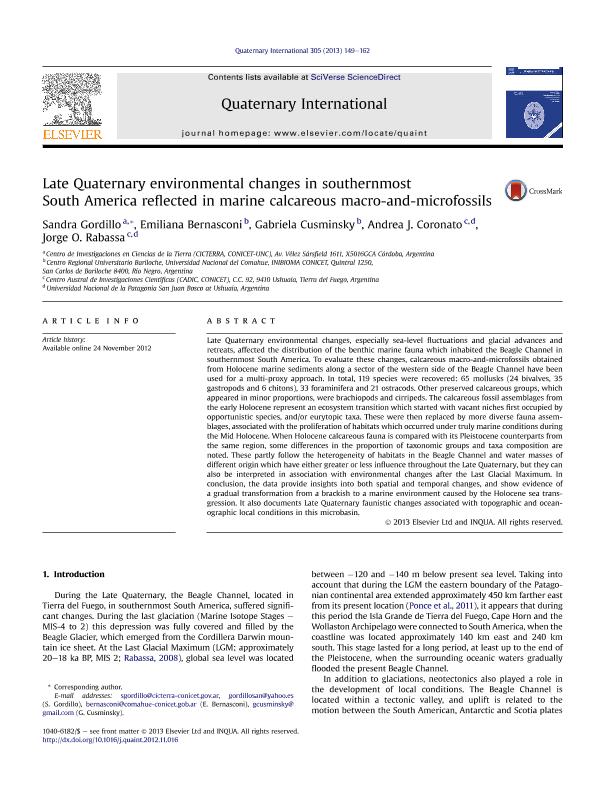Mostrar el registro sencillo del ítem
dc.contributor.author
Gordillo, Sandra

dc.contributor.author
Bernasconi, Emiliana

dc.contributor.author
Cusminsky, Gabriela Catalina

dc.contributor.author
Coronato, Andrea Maria Josefa

dc.contributor.author
Rabassa, Jorge Oscar

dc.date.available
2018-01-09T18:45:06Z
dc.date.issued
2012-11
dc.identifier.citation
Rabassa, Jorge Oscar; Coronato, Andrea Maria Josefa; Cusminsky, Gabriela Catalina; Bernasconi, Emiliana; Gordillo, Sandra; Late Quaternary environmental changes in southernmost South America reflected in marine calcareous macro-and-microfossils; Elsevier; Quaternary International; 305; 11-2012; 149-162
dc.identifier.issn
1040-6182
dc.identifier.uri
http://hdl.handle.net/11336/32689
dc.description.abstract
Late Quaternary environmental changes, especially sea-level fluctuations and glacial advances and retreats, affected the distribution of the benthic marine fauna which inhabited the Beagle Channel in southernmost South America. To evaluate these changes, calcareous macro-and-microfossils obtained from Holocene marine sediments along a sector of the western side of the Beagle Channel have been used for a multi-proxy approach. In total, 119 species were recovered: 65 mollusks (24 bivalves, 35 gastropods and 6 chitons), 33 foraminifera and 21 ostracods. Other preserved calcareous groups, which appeared in minor proportions, were brachiopods and cirripeds. The calcareous fossil assemblages from the early Holocene represent an ecosystem transition which started with vacant niches first occupied by opportunistic species, and/or eurytopic taxa. These were then replaced by more diverse fauna assemblages, associated with the proliferation of habitats which occurred under truly marine conditions during the Mid Holocene. When Holocene calcareous fauna is compared with its Pleistocene counterparts from the same region, some differences in the proportion of taxonomic groups and taxa composition are noted. These partly follow the heterogeneity of habitats in the Beagle Channel and water masses of different origin which have either greater or less influence throughout the Late Quaternary, but they can also be interpreted in association with environmental changes after the Last Glacial Maximum. In conclusion, the data provide insights into both spatial and temporal changes, and show evidence of a gradual transformation from a brackish to a marine environment caused by the Holocene sea transgression. It also documents Late Quaternary faunistic changes associated with topographic and oceanographic local conditions in this microbasin.
dc.format
application/pdf
dc.language.iso
eng
dc.publisher
Elsevier

dc.rights
info:eu-repo/semantics/openAccess
dc.rights.uri
https://creativecommons.org/licenses/by-nc-nd/2.5/ar/
dc.subject
Late Quaternary
dc.subject
Mollusks
dc.subject
Paleontology
dc.subject
Tierra del Fuego
dc.subject.classification
Meteorología y Ciencias Atmosféricas

dc.subject.classification
Ciencias de la Tierra y relacionadas con el Medio Ambiente

dc.subject.classification
CIENCIAS NATURALES Y EXACTAS

dc.title
Late Quaternary environmental changes in southernmost South America reflected in marine calcareous macro-and-microfossils
dc.type
info:eu-repo/semantics/article
dc.type
info:ar-repo/semantics/artículo
dc.type
info:eu-repo/semantics/publishedVersion
dc.date.updated
2015-06-11T18:20:38Z
dc.journal.volume
305
dc.journal.pagination
149-162
dc.journal.pais
Países Bajos

dc.journal.ciudad
Amsterdam
dc.description.fil
Fil: Gordillo, Sandra. Consejo Nacional de Investigaciones Científicas y Técnicas. Centro Científico Tecnológico Conicet - Córdoba. Centro de Investigaciones en Ciencias de la Tierra. Universidad Nacional de Córdoba. Facultad de Ciencias Exactas Físicas y Naturales. Centro de Investigaciones en Ciencias de la Tierra; Argentina
dc.description.fil
Fil: Bernasconi, Emiliana. Consejo Nacional de Investigaciones Científicas y Técnicas. Centro Científico Tecnológico Conicet - Patagonia Norte. Instituto de Investigaciones en Biodiversidad y Medioambiente. Universidad Nacional del Comahue. Centro Regional Universidad Bariloche. Instituto de Investigaciones en Biodiversidad y Medioambiente; Argentina
dc.description.fil
Fil: Cusminsky, Gabriela Catalina. Consejo Nacional de Investigaciones Científicas y Técnicas. Centro Científico Tecnológico Conicet - Patagonia Norte. Instituto de Investigaciones en Biodiversidad y Medioambiente. Universidad Nacional del Comahue. Centro Regional Universidad Bariloche. Instituto de Investigaciones en Biodiversidad y Medioambiente; Argentina
dc.description.fil
Fil: Coronato, Andrea Maria Josefa. Universidad Nacional de la Patagonia; Argentina. Consejo Nacional de Investigaciones Científicas y Técnicas. Centro Austral de Investigaciones Científicas; Argentina
dc.description.fil
Fil: Rabassa, Jorge Oscar. Universidad Nacional de la Patagonia; Argentina. Consejo Nacional de Investigaciones Científicas y Técnicas. Centro Austral de Investigaciones Científicas; Argentina
dc.journal.title
Quaternary International

dc.relation.alternativeid
info:eu-repo/semantics/altIdentifier/doi/http://dx.doi.org/10.1016/j.quaint.2012.11.016
dc.relation.alternativeid
info:eu-repo/semantics/altIdentifier/url/http://www.sciencedirect.com/science/article/pii/S1040618212033277
Archivos asociados
